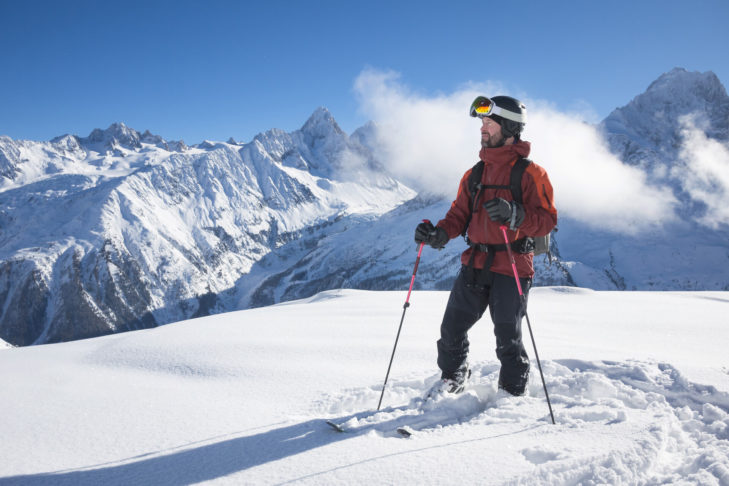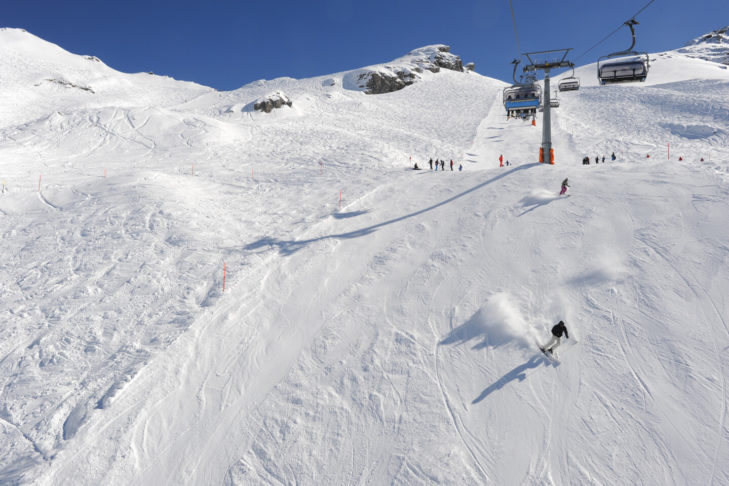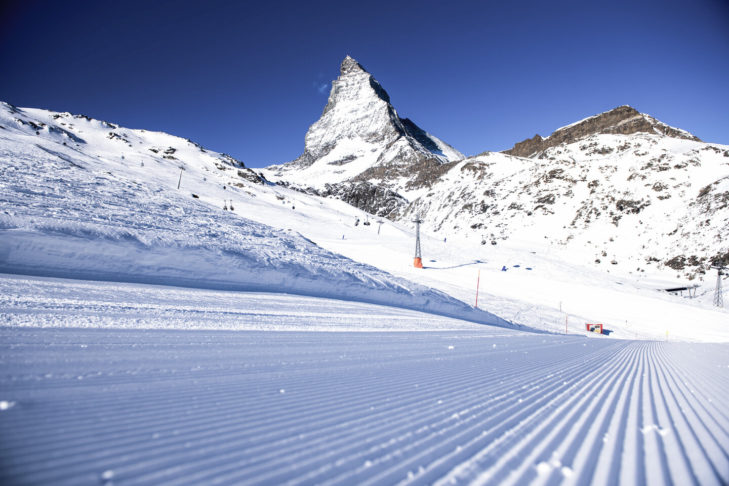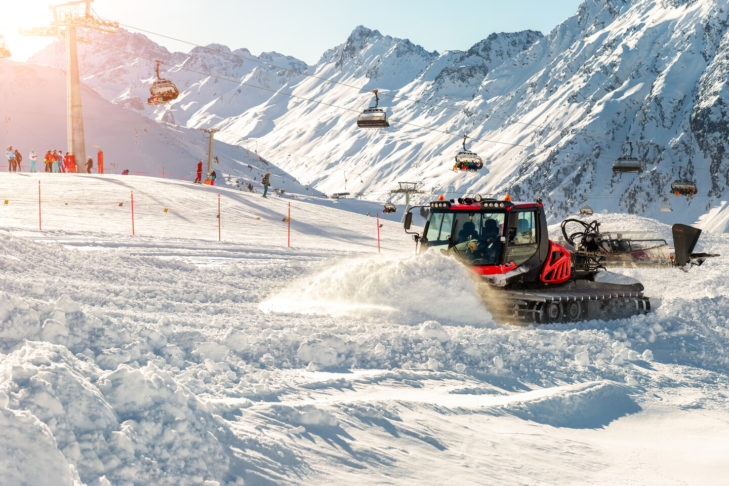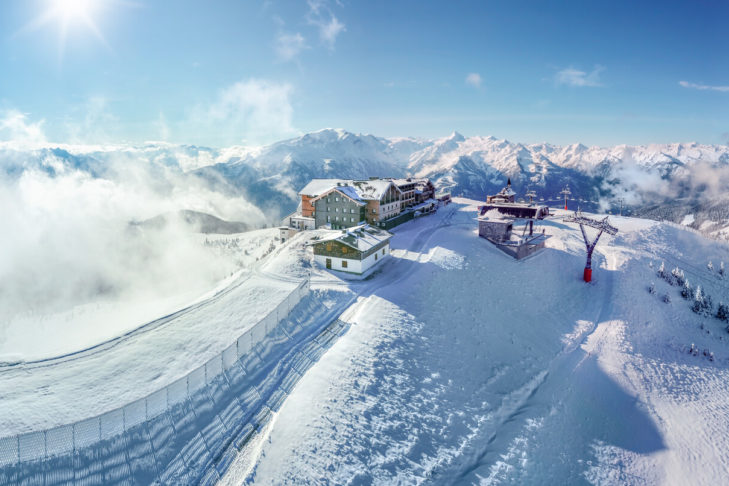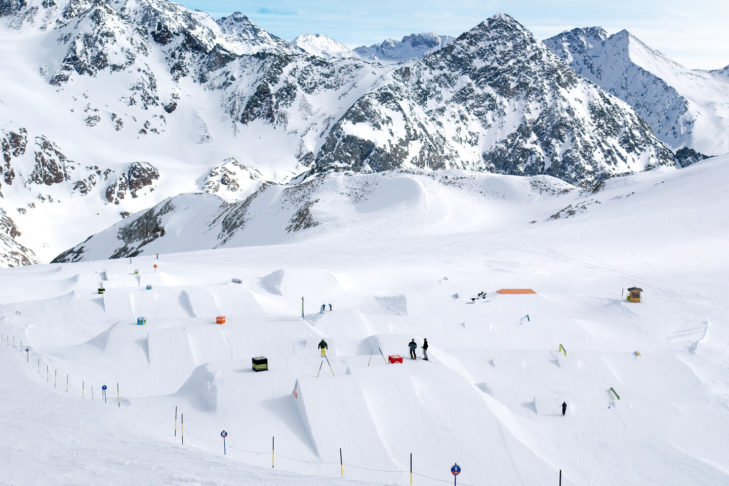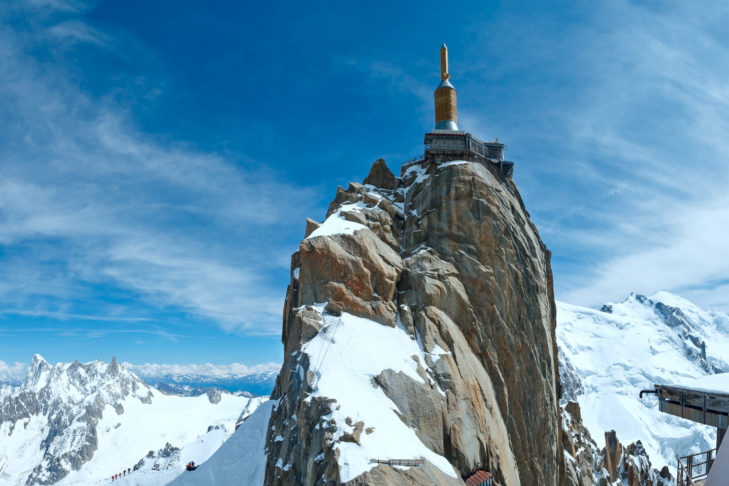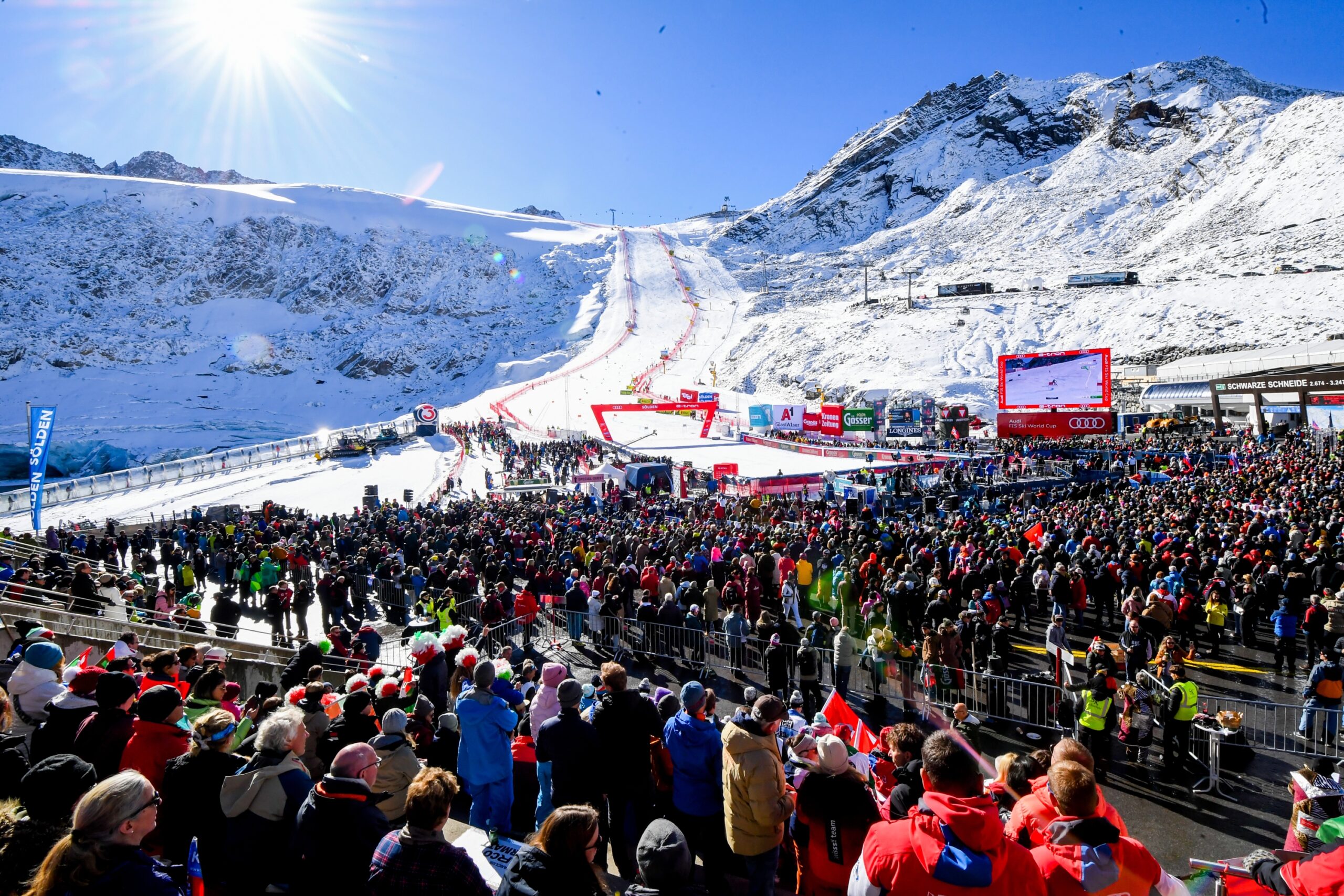The fascination with the white mountain world and its unique landscapes remains undiminished, as does the enthusiasm for skiing and activity in the great outdoors. However, many skiers are increasingly concerned about not harming the environment and climate. As a result, many ski resorts today have implemented eco-friendly measures to protect the precious resources that are essential to their existence. SnowTrex highlights this commitment by showcasing a selection of 11 destinations and detailing their sustainability efforts.
An overview of particularly climate-friendly ski resorts in Europe
| Ski resort | Country | Piste kilometres |
|---|---|---|
| Flims-Laax-Falera | Switzerland | 188 |
| Arosa-Lenzerheide | Switzerland | 225 |
| Davos-Klosters | Switzerland | 222 |
| Engelberg-Titlis | Switzerland | 82 |
| Zermatt | Switzerland | 200 |
| Silvretta Arena | Austria | 239 |
| Zell am See/Kaprun | Austria | 138 |
| Stubai Gletscher | Austria | 65 |
| Chamonix | France | 172 |
| Val di Fassa-Carezza | Italy | 110 |
| Val di Fiemme-Obereggen | Italy | 111 |
Flims-Laax-Falera (Switzerland)
The ski resort of Flims-Laax-Falera has drawn up a “6-point plan” to help it become the world’s first self-sustaining alpine destination. And that means not only that the entire energy consumption of 280 gigawatt hours (GWh) is to be obtained from regional sources, but also that this energy is 100% renewable. In detail, the 6-point plan is made up as follows:
- Maximum energy efficiency: refurbishment of existing buildings and expansion of e-mobility as well as a stronger focus on walking and cycling
- Decarbonisation of the existing buildings: replacement oil heating systems and using climate-friendly building materials
- Solar architecture: installation of photovoltaic panels on roofs and facades as well as the establishment of Plus Energy Buildings (PEB)
- Electrification of mobility: use of battery- and hydrogen-based vehicles and expansion of the charging infrastructure
- Large-scale power plants: procurement of the entire energy demand from photovoltaic and hydropower plants as well as wind farms
- Energy storage: use of storage lakes, hydrogen and batteries
Flims-Laax-Falera is a ski resort in the Swiss canton of Graubünden and consists of the villages of Flims, Laax and Falera. The ski area has a total of 188 kilometres of pistes, divided into 88 kilometres of blue pistes, 81 kilometres of red pistes and 18 kilometres of black pistes. The highest point in the ski area is at 3,081 m.
In Laax, efforts are being made to harmonise life on the slopes with that of the flora and fauna as much as possible. The successes that the so-called “Greenstyle” concept has achieved so far are outlined in the following video:
Please also note that by using our services and integrating the YouTube API Services, the YouTube Terms of Service and the YouTube API Services Terms apply and your use of our website is deemed to be acceptance of these terms.
Arosa-Lenzerheide (Switzerland)
Innovations in the area of sustainability have been at the top of the agenda in Arosa-Lenzerheide for 15 years. In particular, old cable cars are being replaced by new ones. This also includes the Täli chairlift. The new installation will be equipped with a direct drive without gears, which consumes around 10% less energy. In addition, the mountain station will be equipped with photovoltaic modules, just like the Heidbüel mountain station. Behind the scenes, another major change is also taking place in the ski area. By 2023, the cable cars will replace all oil heating systems in the buildings with heat pumps. The electricity for the new systems will then also come from 100% renewable energy sources.
The cable cars have been following this path since 2015, with hydropower from Graubünden being the most important source of energy. In addition, the solar systems on the mountains now produce so much electricity that the Stätzerhorn and Täli chairlifts, among others, can be operated throughout the winter. Together with the Italian ski resort of Val di Fassa-Carezza, Arosa-Lenzerheide is also part of the “Alpine Climate Ski Resorts” project, which primarily aims to set new standards in piste preparation. In the shadow of the Parpaner Rothorn (2,865 m), where winter sports enthusiasts will find a total of 225 kilometres of pistes served by a total of 43 lifts, this is a truly mammoth task. However, thanks to GPS-controlled snow depth measurement, the entire process can be controlled more intelligently and water consumption for snowmaking can be reduced.
Other energy-saving measures include using the waste heat from the drive motors of the cable car systems as warm air to heat the command centres in the valley and on the mountain. In addition, the cable car company put a comprehensive building management system into operation for the first time in 2009. The technology makes it possible to record the electricity and water requirements of mountain restaurants, stations and administrative buildings and thus to plan energy consumption more sustainably.
Fast arrival and departure by train and public transport
Winter sports enthusiasts who can show a valid cable car ticket for the ski area at the station in Chur, Switzerland can travel free of charge by bus to Lenzerheide or Arosa. In the villages, the village shuttles are also available to all guests outside the main winter season. These are also free of charge and therefore an ideal alternative to travelling by car.
Davos-Klosters (Switzerland)
The vision in Davos-Klosters is very clear: to be the first holiday resort in Switzerland to achieve “net zero” CO₂ emissions. The fact that the Federal Council of the Swiss Confederation has decided to achieve this goal for the entire country by 2050 shows just how ambitious this endeavour is. In the shadow of the Weissfluh summit (2,844 m), the project is called “Davos 2030”. The “myclimate Climate Fund Davos” was also founded for this purpose. Companies and organisations from both locations can participate. Guests and visitors who stay overnight or shop there pay a small amount towards local CO₂ reduction projects if they wish. In return, hotels, restaurants and other businesses contribute the same amount. This pot is then used to pay for very specific sustainability measures.
In the towns of Davos and Klosters as well as in the neighbouring ski resorts, a true winter wonderland awaits guests year after year:
Please also note that by using our services and integrating the YouTube API Services, the YouTube Terms of Service and the YouTube API Services Terms apply and your use of our website is deemed to be acceptance of these terms.
In addition to the ice hockey club HC Davos, the local tourism associations and some hotels, Davos Klosters Bergbahnen have also joined the “myclimate Climate Fund Davos”. As the operator of a ski resort that offers winter sports enthusiasts 222 kilometres of perfectly groomed pistes served by 52 lifts, they see themselves as having a clear responsibility when it comes to sustainability. With investments totalling several million Swiss francs, many environmental projects have been implemented on the mountain.
Cable cars invest in energy infrastructure in the ski resort
Having already implemented around 80 projects in the areas of efficiency, energy and the environment, more are to follow in the future. The focus of Davos Klosters Bergbahnen is clearly on the topic of energy. The aim is to produce a large proportion of the electricity required itself, exclusively from renewable energy sources. To this end, 40 solar panels are to be installed on buildings in the ski area and three small hydroelectric power plants will supply additional energy. Surplus energy that is not required for snowmaking or operating the lifts will be fed directly into the local power grid. Another step towards CO₂ neutrality is the elimination of heating oil: all oil heating systems in the buildings on the Weissfluh summit have already been decommissioned. Together with other measures, the ski resort saves 45,000 litres of heating oil every year!
Davos-Klosters is also doing a lot for the local flora and fauna. For example, scrub clearance is underway in Gämpi, where spruce trees, larches and shrubs have been removed to give the fen, a particularly valuable habitat for animals and plants, more space again. The same applies to the dry meadow habitat, whose total area in Switzerland has decreased by around 95% since 1900. This is why employees of the cable car company are intensively maintaining a large dry meadow on Seewer Berg on Parsenn. Reforestation is also being carried out on the Wiesner Alp and on the Rinerhorn in the Würzenwald. The project is scheduled to run for 15 years and is intended to ensure that the capercaillie population is maintained and biodiversity as a whole increases again.
Engelberg (Switzerland)
Above the charming monastery town in the canton of Obwalden in central Switzerland lies the Engelberg-Titlis ski area, one of the country’s most snow-sure winter sports regions. The Engelberg destination, which boasts 82 kilometres of pistes as well as almost 30 lifts and gondolas at an altitude of between 1,000 and 3,020 metres, is also made particularly attractive by its beautiful location in the shadow of a glacier. And to ensure that this unique nature can continue to offer just that in the future, the topic of sustainability and climate protection plays a major role in the municipality today.
Engelberg has held the title of “energy town” since 2011. For this, the town had to implement a total of 79 climate protection measures in 6 areas. Among other things, 60% of the households will be supplied with ecological district heating from the Engelberg heating plant since 2019. The conversion of the entire electricity supply to 100% renewable energies took place in 2022. With the help of these measures, those responsible want to reduce the energy demand for hot water and space heating by 25% by 2030 compared to 2010. In fact, all gondolas and lifts in Engelberg are supplied with electricity generated 100% from hydropower.
In the village itself, two thirds of the streets are 30 km/h zones. A train runs every hour as a direct connection to and from Lucerne and there are free buses that of course also take winter sports enthusiasts to the valley stations. Recycling is also a major issue in the village. As part of a sustainable waste management system, kitchen waste from almost all restaurants is collected by an e-truck in a CO₂-neutral way before it is used to generate electricity. And in other respects too, much of the catering in Engelberg relies exclusively on local food, while local businesses construct their buildings using innovative and energy-saving concepts or renovate them accordingly for sustainable operation.
Zermatt (Switzerland)
At the foot of the world-famous Matterhorn lies the ski resort of Zermatt. On 200 kilometres of pistes, skiers and snowboarders can conjure up their turns in the snow to their heart’s content. 32 lifts take winter sports enthusiasts up to 3,883 m on the Kleine Matterhorn. From this record-breaking height, the surrounding 4,000-metre mountains and many other Alpine highlights can be admired. And it is precisely this unique nature that the people of Zermatt want to preserve for future generations. Accordingly, there is a great deal of commitment in the village when it comes to the topics of climate and sustainability.
The municipality has been one of the most car-free places in the Alps since 1961. The only vehicles on the roads today are the electric cars developed in Zermatt itself. Then there are bicycles, horse-drawn carriages and electric buses that drop skiers off directly at the valley stations of the gondolas on their way to the ski area. Traditionally, the municipality can also shine with its train connections. The Gornergratbahn, the Glacier Express and the Matterhorn Gotthard Bahn all stop directly in the village.
As the operator of the ski area, Zermatt Bergbahnen AG already took a particularly environmentally conscious approach in 2002 with the overall concept “Sustainable Ski Area Zermatt”. In addition to so-called environmental construction supervision by natural scientists, a wildlife and forest protection programme, as well as the ongoing elimination of environmental damage caused by old lift systems, for example, environmental management on and off the slopes now goes even further.
Zermatt relies on the power of water
While the ski area’s 29 snowcats now run exclusively on sulphur-free “eco speed” diesel, which reduces carbon monoxide emissions by more than 10%, over 690 solar panels have been installed on various new buildings in the ski area since 2009. Together they produce 212,000 kilowatt hours (kWh) of electricity a year, saving almost 30 t of CO₂ each time over this period.
And anyway, Zermatt is not only able to supply itself completely with electricity from renewable energies. The town can even partially supply the rest of the country. In terms of electricity generation, the showpiece of the town since 1965 has been the 285 m high dam wall of Lac des Dix. After all, Switzerland’s highest structure is part of the Swiss Confederation’s most powerful hydroelectric power station, the Grande Dixence. An incredible 2 billion kWh of electricity can be generated here per year. This corresponds to about 20% of the storable energy in Switzerland or the electricity consumption of 500,000 households!
Silvretta Arena (Austria)
Ischgl is not only Tyrol’s après-ski capital, but is now also considered the largest climate-neutral ski resort in the Alps with the Silvretta Arena ski area. In order to be able to bear this title, the ski area’s total greenhouse gas emissions were first determined in order to find out which measures were necessary to achieve the actual goal. However, since emissions are unavoidable in the end, Silvrettabahn AG, as the ski area operator, invests in an international climate protection project for reforestation in Peru as well as in tree plantations in the protective forests of the Austrian Federal Forest in the Paznaun Valley and around Ischgl to compensate for the CO₂ emissions.
However, winter sports enthusiasts in the cross-border ski area at an altitude of up to 2,872 m hardly notice any of these measures. This, too, means that nothing stands in the way of unlimited fun on the slopes in the Silvretta Arena, which is accessed by 41 lifts and offers skiers and snowboarders 239 kilometres of blue, red and black pistes.
New snow groomers in Ischgl to consume 20% less fuel
The Silvretta Arena, like so many other ski resorts, sees the most potential for CO₂ savings in the energy sector. Here on the mountain in Ischgl, solar technology and heat recovery now save around 80,000 litres of heating oil per year and at the same time prevent the emission of 244 tonnes of carbon monoxide. Those responsible took further innovative steps in heating the mountain restaurant “Ischgl Slope Food” and the valley station of the Gampenbahn E4. Both buildings are supplied by geothermal energy and thus manage completely without fossil fuels. The Silvretta Therme is also operated according to a similar concept. The majority of the building complex is heated via geothermal probes, which ultimately saves almost 1,300 tonnes of CO₂ per year.
Climate-friendly thinking is also very much in evidence on the roads and slopes in the Paznaun Valley. For example, the ski bus network in Ischgl was recently massively expanded. The shuttles bring winter sports enthusiasts together to the valley stations, which in turn reduces car traffic. On the mountain, state-of-the-art satellite technology also helps to ensure that the snow cannons have to produce as little snow as possible. By measuring the snow depth via GPS, the snow groomer drivers can also see on a screen in the cockpit where the snow cover is thinnest and should therefore be reworked. And speaking of snow groomers. In the coming years, the current generation of vehicles will gradually be replaced by hybrid models that require up to 20% less fuel.
Zell am See-Kaprun (Austria)
Particularly with a view to the effects of climate change on the iconic glacier on the Kitzsteinhorn, those responsible at the Zell am See-Kaprun ski resort have long had sustainability firmly in their sights. The basis here is a quality, environmental and energy management system that has been established for many years. An approach that has already been awarded prestigious environmental certificates several times. For example, Zell am See-Kaprun has officially become a climate and energy model region.
One of the central elements here is the power supply of the gondolas and lifts with 100% renewable energies. In this case, the cable cars obtain the electricity needed to operate the facilities such as the ultra-modern “Gletscherjets” 3 and 4 entirely from local hydroelectric power plants. The main energy source here is the large reservoirs of the Kaprun hydroelectric power plants. For visitors who are interested in exactly how the whole process of generating electricity there works, a visit to the information centre of the Kaprun Valley Association is a must. Here they can also take a direct look into the machine hall and thus into the heart of the plant.
In the two ski resorts of Kitzsteinhorn/Maiskogel (Kaprun) and Schmittenhöhe (Zell am See), skiers and snowboarders of all levels have 138 kilometres of pistes at their disposal, including 59 blue, 51 red and 28 black, at an altitude of up to 3,029 metres. The local mountains of the two ski resorts as well as the glacier are accessible by 50 lifts and gondolas.
Zell am See stands out with direct rail connections
When it comes to piste maintenance and the rest of everyday operations, the focus is also on climate-friendly measures. For example, the buildings in the ski area are gradually being equipped with solar systems, while most of the snow groomer fleet now has hybrid drives. In addition, the cable cars in Zell am See-Kaprun rely on transparency by regularly informing about the status of their own environmental activities. In the course of the “Respect your limits” campaign of the Salzburg provincial government, winter sports enthusiasts are also openly sensitised to the issue of animal welfare in the ski area as well as flora and fauna on the mountain.
And in order to reduce the CO₂ emissions caused by guests travelling by car and still have an attractive mobility offer up their sleeves, the two resorts also have a strategy. On the one hand, free ski buses run between Kaprun and Zell am See. In addition, winter sports enthusiasts on the way to the Kitzsteinhorn can already do without their own cars. Finally, the connection of Zell am See to the railway network of the Austrian Federal Railways (ÖBB) is so good that it is very easy to get to the ski area by train. In addition to direct connections from almost all cities in the Alpine Republic, trains from Germany and Switzerland also stop regularly on the tracks of the station in the centre of Zell am See.
Stubai Gletscher (Austria)
Similar to the Kitzsteinhorn, the basis of life of the Stubai Gletscher ski area is eternal ice. And this needs to be protected from the consequences of climate change. In order to be able to offer winter sports enthusiasts a unique piste experience on 25 kilometres of blue, 15 kilometres of red and 25 kilometres of black runs at an altitude of up to 3,212 m in the coming years, those responsible in the Stubaital have therefore taken extensive climate protection measures. These include the modernisation and maintenance of the 26 lifts.
The 3S Eisgratbahn, which opened in 2016, plays a pioneering role here. Thanks to its special construction, it requires less energy. And on the way down to the valley, the gondolas even generate electricity that is fed directly into the grid. All in all, 100% of the energy needed in the glacier ski area for snowmaking and water pumps, as well as for lifts, building heating and lighting, comes from renewable sources of electricity.
In terms of mobility, the Stubaital, like many other ski resorts, has invested in a free ski bus network. In addition, 4 e-charging stations are available in the car park of the Stubai Glacier cable car. The employees of the cable cars can also do without their own cars. Instead, up to 285 people a day are picked up by 31 employee shuttles, which also stop at the employee residences in the area. These accommodations were built so that the way to work is no longer so far for the staff as a whole.
Slopes on the Stubai Glacier are being greened and rewilded
The same principle, that of shorter transport routes, is also applied to food. Thus, the food service industry around the Stubai Glacier only sources local products and, in addition, recycles all the waste that can be handed in at 29 public waste separation stations, just like the rest of the valley. For snow production in winter, the Stubai Glacier also relies on several storage ponds. This means that no groundwater has to be used for the artificial snow. In order to fill the pipes without much pumping, but with the inherent pressure of the water, the storage ponds were created at carefully selected locations on the mountain. Another advantage of this planning is that comparatively few water reservoirs can serve as large a catchment area as possible. This also protects nature, which is cared for on and off the slopes in summer through a special rewilding and greening programme.
Chamonix (France)
In the shadow of the mighty Mont Blanc (4,809 m), people know how important and therefore worth protecting the unique mountain world is. No wonder, then, that the Chamonix ski resort is also firmly focused on environmental protection these days. In order to improve climate protection, targeted investments have been made on Europe’s highest mountain for years. In the areas of mobility, habitat maintenance, energy, waste disposal and recycling management. And Chamonix was already awarded for this commitment in 2013. As one of the first ski destinations ever, the resort was allowed to carry the prestigious eco-label “Flacon Vert” (Green Snowflake).
On the way to the skiing area, which offers 172 kilometres of slopes, 60 lifts and an altitude of up to 3,275 m, winter sports enthusiasts today also learn relatively quickly about the term “soft mobility”. The concept in Chamonix is to rely fully on e-shuttles as well as hydrogen and gas-powered buses, the expansion of railway lines, cycle paths and pedestrian zones. Since 2005, a project has also been promoted that enables the free transport of 3.2 million visitors a year by bus and train to the valley.
Chamonix’s citizens are committed to renewable energies
Since 2019, the winter sports resort and the ski area have been drawing a large part of its energy from the Taconnaz hydroelectric power plant. The plant supplies 12.5 million kilowatt hours (kWh) of electricity per year. At the end of 2022, the Bourgeat power plant was also launched, which supplies Chamonix with a further 3 million kWh of electricity per year. In addition, the citizens are working on their own initiative to expand solar energy in the town. Their achievements: In the meantime, they have financed the installation of photovoltaic systems on the roofs of 11 strategically located buildings.
In the field of environmental protection, the mountain guides of Chamonix 2021 also set up a foundation for the protection of the environment and nature in the high mountains (FOEHN). The organisation is financed by donations from companies and private individuals from the region. And the money is used to support initiatives that care for the protection of nature in the high altitudes of the Mont Blanc massif. Subsequently, the local cable car operator, the Compagnie du Mont Blanc, founded its own observatory for biodiversity and landscape in 2014. Thanks to the commitment of its own experts, a group of native black grouse has been discovered near Le Prarion. In order to protect the animals, a large-scale resting zone has been set up here. In winter, skiing in deep snow is prohibited in this area. This measure has apparently led to a noticeable increase in the number of wild birds in the region in recent years.
Val di Fassa-Carezza (Italy)
Located in the middle of the Dolomites UNESCO World Heritage Site, sustainability plays an extremely important role in the Val di Fassa-Carezza ski area. Thus, winter sports enthusiasts can hit the slopes here in a climate ski area. This is another reason why the resort of Carezza won the Climate Investment Award. In addition, it is part of the Climate Neutrality Alliance 2025 and can also show several environmental certificates. Among them is the GSTC sustainability certificate, which is considered the highest certification of its kind in tourism worldwide.
The fact that skiers and snowboarders can enjoy winter sports on a total of 110 kilometres of pistes at an altitude of between 1,448 and 2,625 metres as carefree as in only a few places in the Alps is primarily thanks to the Eisath family. The father, Georg, who has been considered one of the world’s most sought-after snow cannon experts for over 40 years, and his son, former World Cup ski pro Florian, jointly manage the local cable car.
As part of the “Alpine Climate Resorts” project, which also includes Arosa-Lenzerheide in Switzerland, the Eisaths want to continue setting standards, especially in the area of piste preparation. For example, the snow cannon technology is equipped with an intelligent control system that enables the entire ski area to be covered in 80 hours. And it does so precisely when the temperatures at the beginning of winter drop to -10 to -15 degrees. This creates a snow cover that lasts until spring and thus requires less water and electricity to maintain. With the help of snow depth measurement and GPS tracking, the six snow groomers in Carezza also have to be used one hour less every evening. This reduces fuel consumption by a total of 25%.
How the concept of environmentally friendly ski tourism works in Carezza is explained by Florian Eisath, head of the ski resort, in the following video:
Please also note that by using our services and integrating the YouTube API Services, the YouTube Terms of Service and the YouTube API Services Terms apply and your use of our website is deemed to be acceptance of these terms.
Carezza comes back to life through environmental protection
The majority of the water used to produce snow in the ski resort comes from its own storage reservoir. The facility is now considered one of the largest of its kind in South Tyrol and provides additional independence. Both from nature and from external water sources. And to save even more energy, the lifts in Carezza can be deliberately switched off completely at times when there are few visitors.
Another not insignificant part of the overall concept is the reduction of environmental pollution caused by exhaust fumes. Instead of using their own cars, guests and locals can use the local buses. This service is also available when there are events in the ski area. And they are all organised as so-called “green events”. This means that care is taken to produce as little waste as possible at the events and to separate it as much as possible at the end. Flyers with information are not to be found here either, as no paper is to be wasted and therefore everything has been switched to digital communication. These are all measures that made it possible to resume winter operations in Carezza in 2008. A very positive side effect: by creating new jobs here, it was also possible to stop the exodus of the young population in the village in particular.
Val di Fiemme-Obereggen (Italy)
“Obereggen loves – yes, even lives – its nature.” This motto has been adopted by the team at the Val di Fiemme-Obereggen ski area. And as such, environmental protection is high on the agenda in Val d’Ega. After all, winter sports enthusiasts should be able to enjoy carving down the slopes at an altitude of up to 2,388 m in the future. And with 37 km of blue slopes, 57 km of red, and 17 km of black, which are all served by 50 lifts, there is a suitable terrain for every skier and snowboarder.
Thanks to extensive climate protection measures, both in the village and in the ski area, Obereggen was awarded the “ISO 14001” environmental protection certificate as early as 2004. Supported by an environmental management system, transportation has been gradually shifted towards sustainable transport over the past 20 years. This means: less car traffic and more public transportation. And this makes it possible for visitors to use the hiking and ski buses with the “Eggental Mobil Card” and thus travel free of charge between the valley stations and all the communities in the valley.
This clip shows how beautiful skiing on the slopes in Obereggen in the shadow of the Dolomite peaks can be:
Please also note that by using our services and integrating the YouTube API Services, the YouTube Terms of Service and the YouTube API Services Terms apply and your use of our website is deemed to be acceptance of these terms.
No one in the village has to freeze either. After all, since 2007 a district heating system has ensured that Obereggen can rely completely on regional biomass as an energy source. Thanks to the sustainable heating system, 500,000 litres of heating oil are saved every year and, of course, the transport of the fuel in tankers. In addition, the plant, in which woodchips are burnt, is equipped with a state-of-the-art flue gas cleaning system. This reduces the emissions emitted to a minimum.
Obereggen draws its energy from earth and water
In addition to “green” heat, the ski resort in the Dolomites is also supplied with “green” electricity. And in this case, it is generated with hydropower. In South Tyrol’s largest hydroelectric power plant in Kardaun near Bolzano. Thanks to the powerful turbines of the plant, all valley and mountain stations in Obereggen can rely completely on electricity from renewable energy. The same applies to the lifts and the ski and alpine huts. A somewhat less “prominent” but very effective part of the energy mix in the village is geothermal energy. With geothermal energy, which is derived from boreholes drilled into deep rock faces or from deep waters, the interiors of the Oberholz mountain hut in the ski area, for example, can currently not only be heated in winter, but also cooled in summer without emissions.
Fancy a climate-friendly ski holiday? Then head to Laax, Ischgl, Engelberg, La Plagne, Obereggen or Chamonix.
FAQ’s on climate-friendly ski resorts
Which climate-friendly ski resorts are there?
In Europe and especially in the Alps, there are many ski resorts that are developing and implementing measures to become more climate-friendly. Examples include the ski resorts of Flims-Laax-Falera, Engelberg, Zermatt, the Silvretta Arena, Zell am See-Kaprun, the Stubai Glacier, La Plagne, Chamonix, Carezza and Obereggen.
What measures are ski resorts taking to become more climate-friendly?
Ski resorts in the Alps are developing and implementing a wide variety of climate-friendly measures and concepts. Many, for example, opt for an energy supply for the lifts from exclusively renewable energy. Others measure their greenhouse gas emissions and offset them through environmentally friendly projects or the purchase of climate protection certificates.
Why are ski resorts becoming more climate-friendly?
Many ski resorts increasingly want to protect nature and its resources, and thus also their own livelihoods. On the one hand, this is because they actively notice how climate change affects them. On the other hand, travellers and thus the guests of ski resorts are also paying more and more attention to environmentally friendly aspects of ski holidays.
What makes a holiday in a ski resort particularly harmful to the climate?
Most CO₂ emissions actually occur on the journey to the ski resort. The cars used by winter sports enthusiasts alone account for nearly 80% of the climate-damaging greenhouse gases. Accordingly, ski resorts have been focusing on eco-friendly transportation options for years, offering free ski buses, expanding infrastructure for electric mobility, and promoting direct train connections.
Are there also climate-friendly accommodations?
Yes. SnowTrex offers a wide range of sustainable accommodations.

